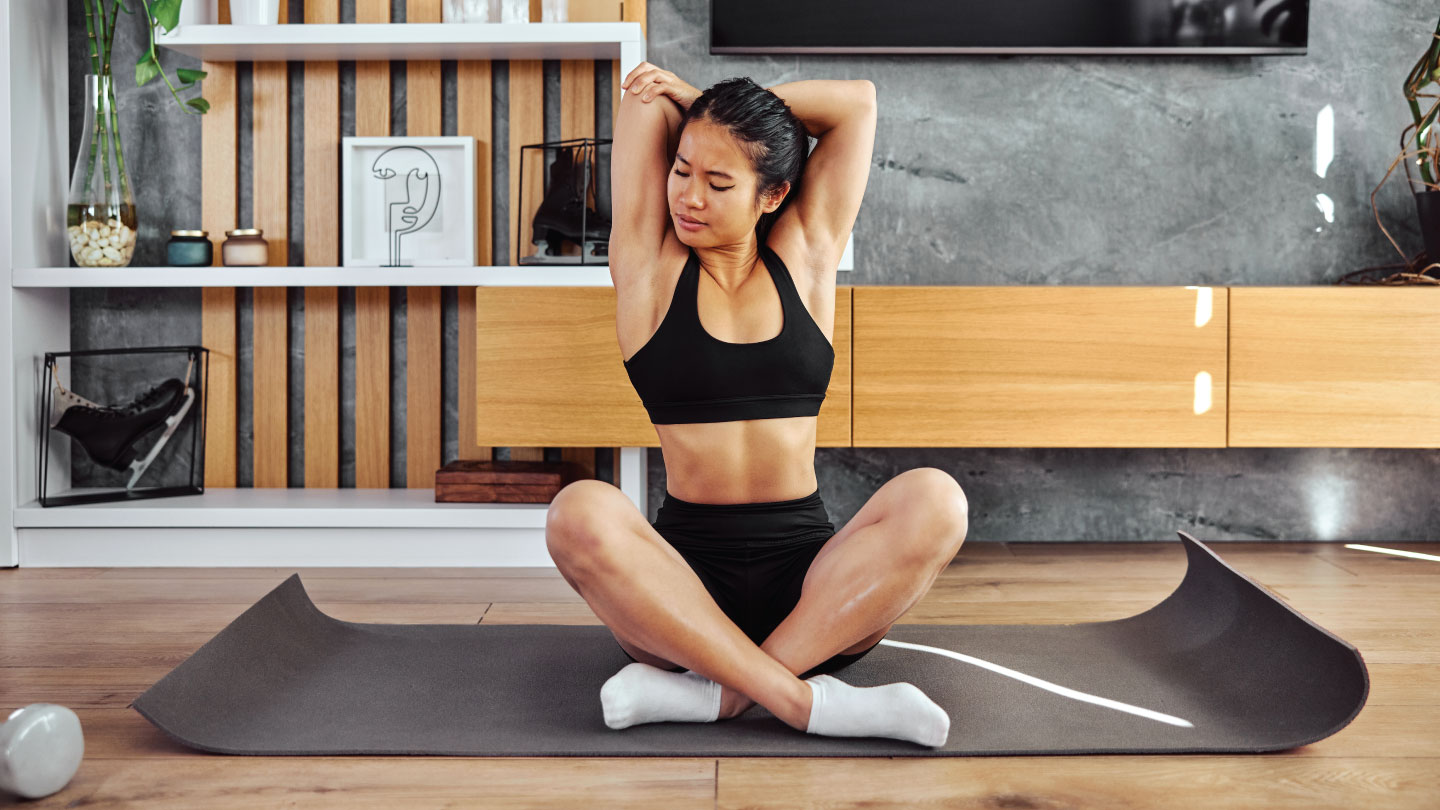Movement
Surya Namaskar: Yoga For Full Body Workout
Tired of the same old HIIT workouts? Yoga asanas are a great way to achieve a full-body workout while reducing stress and increasing flexibility. Explore various postures that target different muscle groups for a well-rounded workout.

In a world where everyone is constantly on the go and looking for ways to stay fit and healthy, yoga has become a popular choice for those seeking a physical and mental workout that doesn't require jumping, lifting, or running. While traditional workouts like HIIT may offer impressive results, they can be daunting for beginners and may not be suitable for everyone. That's where yoga comes in, offering a low-impact, holistic approach to fitness that can benefit people of all ages and fitness levels. It offers numerous benefits to the body, mind, and soul. One of the most significant benefits of practising yoga is that it provides a full-body workout. Whether you’re a beginner or a seasoned practitioner, incorporating yoga asanas into your daily routine can be an excellent way to stay fit and healthy.
Yoga is not a one-size-fits-all practice. There are various types of yoga, each having its own unique benefits. One move that is common to most forms of yoga is the Surya Namaskar. This sequence of moves targets your breath, body and mind.
Unlock insider access to the best movement plans for free! Sign up today.
Surya Namaskar
Surya Namaskar, also known as Sun Salutation, is a series of poses that offer a complete workout for the body. It strengthens the core, improves flexibility, and enhances overall body strength. The sequence is designed to be performed in a flow with each movement synchronised with your breath.
While there are many variations of Surya Namaskar, Sequence A is the most commonly practised and involves a combination of forward and backward bending postures.
Related story: Yoga Is For Everyone: Take Inspiration From These Five Body-Positive Influencers
Here are step-by-step instructions for each pose in the sequence of Surya Namaskar sequence A:
Tadasana (Mountain Pose)
- Stand at the top of your mat with your feet hip-width apart, your arms by your sides, and your palms facing forward.
- Press down through your feet, engage your legs, and lengthen your spine.
- Relax your shoulders down and back.
- Take a few deep breaths and centre yourself.
Utthita Hastasana (Upward Salute)
- Inhale and sweep your arms up overhead, bringing your palms together in a prayer position.
- Gently arch your back and look up towards your hands.
- Keep your shoulders relaxed and away from your ears.
Uttanasana (Standing Forward Bend)
- Exhale and fold forward from the hips, bringing your fingertips or palms to the mat beside your feet.
- Keep your knees slightly bent and your spine long.
- Relax your neck and let your head hang down towards the floor.
Related story: Yoga Posture For Good Sleep
Ardha Uttanasana (Halfway Forward Bend)
- Inhale and lift your torso halfway, lengthening your spine and bringing your hands to your shins or thighs.
- Keep your gaze forward, and your shoulders relaxed.
Related Story: Bulking and Cutting: Ways To Get More Muscle Definition
Chaturanga Dandasana (Half-Plank Position)
- Exhale and step or jump back into a high plank position, with your shoulders directly over your wrists and your body in a straight line.
- Lower down to a low plank position, keeping your elbows close to your sides.
- Keep your core engaged and your legs straight.
Related story: Yoga For Healing
Urdhva Mukha Svanasana (Upward-Facing Dog Pose)
- Inhale and lift your chest and shoulders up, straightening your arms and rolling over your toes.
- Keep your thighs lifted off the mat and your shoulders relaxed away from your ears.
Adho Mukha Svanasana (Downward-Facing Dog Pose)
- Exhale and lift your hips up and back, straightening your arms and legs to come into an inverted "V" shape.
- Keep your hands shoulder-width apart and your feet hip-width apart.
- Press down through your palms and lift up through your hips.
Ardha Uttanasana (Halfway Forward Bend)
- Inhale and step or jump forward, lifting your torso halfway and bringing your hands to your shins or thighs.
- Keep your gaze forward, and your shoulders relaxed.
Uttanasana (Standing Forward Bend)
- Exhale and fold forward from the hips, bringing your fingertips or palms to the mat beside your feet.
- Keep your knees slightly bent and your spine long.
- Relax your neck and let your head hang down towards the floor.
Utthita Hastasana (Upward Salute)
- Inhale and sweep your arms up overhead, bringing your palms together in a prayer position.
- Gently arch your back and look up towards your hands.
- Keep your shoulders relaxed and away from your ears.
Tadasana (Mountain Pose)
- Exhale and bring your hands down to your heart centre, coming back to a standing position.
- Take a few deep breaths and centre yourself before beginning the sequence again.
This completes one round of Surya Namaskar A. You can repeat the sequence several times to create a full practice. Surya Namaskar A is typically performed at the beginning of a yoga class as a warm-up or as a stand-alone practice to energise the body and calm the mind.
Related story: Easy Guide To Injury-Free Yoga Practice
Benefits of Surya Namaskar
Research suggests that practising Surya Namaskar Sequence A on a regular basis can provide several benefits for the full body, including:
Improved flexibility: A 2019 study published in the International Journal of Yoga found that the regular practice of Surya Namaskar improved flexibility and joint mobility in healthy adults.
Increased strength: A 2018 study published in the Journal of Physical Therapy Science found that practising Surya Namaskar regularly increased upper body and core strength in healthy individuals.
Boost cardiovascular health: A 2019 study published in the Journal of Ayurveda and Integrative Medicine found that practising Surya Namaskar for 12 weeks led to a significant improvement in cardiovascular health markers, including lower blood pressure and improved heart rate variability.
Enhanced respiratory function: A study published in the International Journal of Yoga in 2018 found that regular practice of Surya Namaskar improved respiratory function in healthy adults, including increased lung capacity and improved breathing efficiency.
Reduced stress and anxiety: A study published in the Journal of Bodywork and Movement Therapies in 2019 found that practising Surya Namaskar regularly reduced stress and anxiety levels in healthy individuals.
Surya Namaskar can provide significant benefits for the full body, including improved flexibility, strength, cardiovascular health, respiratory function, and stress reduction.
Related story: Yoga Poses To Help You De-Stress
Tips To Make The Sequence More Gentle For Beginners
While Surya Namaskar is ideal for all fitness levels, it may be challenging if this is your first time doing it. Here are some tips to modify the Surya Namaskar sequence to make it more gentle for beginners:
Set your pace: Beginners may find it challenging to keep up with the pace of the Surya Namaskar sequence, so it's important to slow down the movements. Instead of rushing through each posture, encourage beginners to take their time and focus on their breath.
Simplify the postures: Some of the postures in the Surya Namaskar sequence, such as Chaturanga Dandasana (Four-Limbed Staff Pose) and Urdhva Mukha Svanasana (Upward-Facing Dog Pose), can be challenging for beginners. You can modify these postures by encouraging beginners to lower their knees to the ground in Chaturanga and Cobra Pose instead of Upward-Facing Dog.
Use props: Use yoga assists such as blocks, blankets, and straps to make the Surya Namaskar sequence more accessible for beginners. For example, if you are a beginner, you can use blocks to bring the ground closer to your hands in Forward Fold or use a strap to help you reach your feet in Downward-Facing Dog.
Focus on alignment: Proper alignment is important in any yoga practice, but it's especially important for beginners. Encourage yourself to focus on your alignment in each posture, and you can take the help of others for the use of verbal cues to guide you into the correct alignment.
Break it down: The Surya Namaskar sequence can be overwhelming for beginners, so it's helpful to break it down into smaller, more manageable parts. Begin with just a few postures, and gradually add more as the beginner becomes more comfortable with the sequence.
Remember that everyone's body is different, and modifications may need to be made based on your individual needs and abilities. You should listen to your body and move at your comfortable pace, and remind yourself that yoga is a journey, not a destination.
Related story: Find Out How To Perfect The Downward Dog Posture
Tips To Make The Sequence More Challenging
Add variations to each pose: Instead of performing the same basic version of each pose, try adding variations to each pose in the sequence. For example, instead of a traditional forward fold, try a one-legged forward fold or a twisted forward fold.
Increase the number of repetitions: Challenge yourself by performing more repetitions of the sequence than you normally would. Start with five rounds and gradually increase to ten or more.
Incorporate arm balances: Add arm balances such as crow pose or side plank into the sequence to increase upper body strength and balance.
Increase the speed: Instead of moving slowly through the sequence, try performing the postures at a faster pace. This will increase your cardiovascular endurance and challenge your coordination.
Add jumps or hops: Incorporate small jumps or hops between each posture to increase the intensity of the sequence.
Incorporate advanced postures: If you are comfortable with more advanced postures, try incorporating them into the sequence. For example, you can add inversions such as a headstand or handstand.
Modify the sequence: Finally, consider modifying the traditional Surya Namaskar sequence to include different postures or to focus on specific areas of the body. You can also add or remove postures to create a customised sequence that challenges you in new ways.
Related story: 5 Yoga Postures For Better Digestion
Breathing Techniques
Having control over your breathing is essential for yoga andcan greatly enhance the calorie-burning effects of yoga asanas. One of the most commonly used breathing techniques in yoga is Ujjayi breathing, which involves a slow, deep inhalation through the nose, followed by a prolonged exhalation through the throat. This technique is said to create heat in the body, which can help to burn calories and increase metabolism. Additionally, Ujjayi breathing is believed to have a calming effect on the mind, which can reduce stress and promote relaxation.
Another breathing technique commonly used in yoga is Kapalbhati, which involves rapid, forceful exhalations through the nose, followed by passive inhalations. This technique is said to stimulate the abdominal muscles and diaphragm, which can help to improve digestion and increase metabolism. Additionally, Kapalbhati is believed to have a cleansing effect on the body, helping to remove toxins and impurities.
Overall, the benefits of breath control in yoga are numerous, including improved physical health, increased mental clarity, and reduced stress and anxiety. By incorporating different breathing techniques into your practice, you can enhance the calorie-burning effects of yoga asanas, while also improving their overall health and well-being.
Related story: Yoga For A Healthy Spine
Tips For Incorporating Breathing Techniques Into Your Yoga Practice
Start with basic breathing techniques: If you're new to pranayama or yoga breathing, start with simple techniques such as deep belly breathing or diaphragmatic breathing. This will help you get comfortable with the concept of breath control before moving on to more advanced techniques.
Incorporate pranayama into your warm-up: Begin your yoga practice with a few rounds of pranayama to help you relax and focus your mind. Some common pranayama techniques include Ujjayi breathing, Kapalabhati breathing, and Nadi Shodhana (alternate nostril breathing).
Practice pranayama during asanas: Once you're comfortable with basic pranayama, you can start incorporating it into your yoga poses. For example, you can use Ujjayi breathing to help you stay focused during challenging poses or practice breath retention (Kumbhaka) during static holds.
Experiment with different techniques: There are many pranayama techniques to choose from, so don't be afraid to experiment and find what works best for you. Some people find that deep belly breathing works best for them, while others prefer more energising techniques like Bhastrika (bellows breath).
Stay aware of your breath throughout the practice: Whether you're practising pranayama or just breathing naturally, try to stay aware of your breath throughout your yoga practice. This will help you stay present and focused on the present moment.
Remember, the goal of pranayama and yoga breathing is not to force the breath or achieve a certain outcome, but rather to cultivate awareness and control of the breath as a tool for improving overall health and well-being.
Related story: 8 Simple Chair Yoga Poses To Recharge Your Body And Mind
Unlock insider access to the best movement plans for free! Sign up today.
Incorporating yoga asanas into your daily routine can help you achieve a full-body workout while also promoting relaxation and reducing stress. Whether you are new to yoga or a seasoned practitioner, there is always something to learn and improve upon. We hope this story has inspired you to try out different types of yoga, breathing techniques, and the yoga asanas we have introduced. Remember to listen to your body, breathe deeply, and enjoy the journey.
Looking for an exclusive and unique experience, expert staff, and unparalleled member services? Come join us at URLife Studios! We offer a comprehensive range of wellness services that promote optimum well-being. We are a trusted source for unique holistic health and pregnancy care workshops. Our physiotherapists design customised rehab programs based on health conditions.
At UR.Life Studios, we offer a complete multi-disciplined approach to fitness and well-being. The URLife Studio is a luxe wellness oasis, combining sleek modern design, lavish amenities, state-of-the-art equipment and personalised wellness programs.
- Yoga
- Kickboxing
- Pool and Bollywood aerobics
- Pregnancy care workshops
- Customised physiotherapy
- Spa
- Garden Cafe
- Women’s wellness program
EXPLORE MORE
Your posture is whispering a story about stress, screens, and slouching. Here are 6 exercises you must try!
In a world addicted to speed, Shavasana is proof that true regulation begins when you slow down. Discover how this humble pose is the simplest solution to the chaos within you!
When your thoughts won’t slow down, these yoga poses teach your body to stay present in the moment.
If you’re tired of starting over, this is the timeline that finally aligns with how your metabolism adapts and how habits stick.







.jpg)
.jpg)
.jpg)
